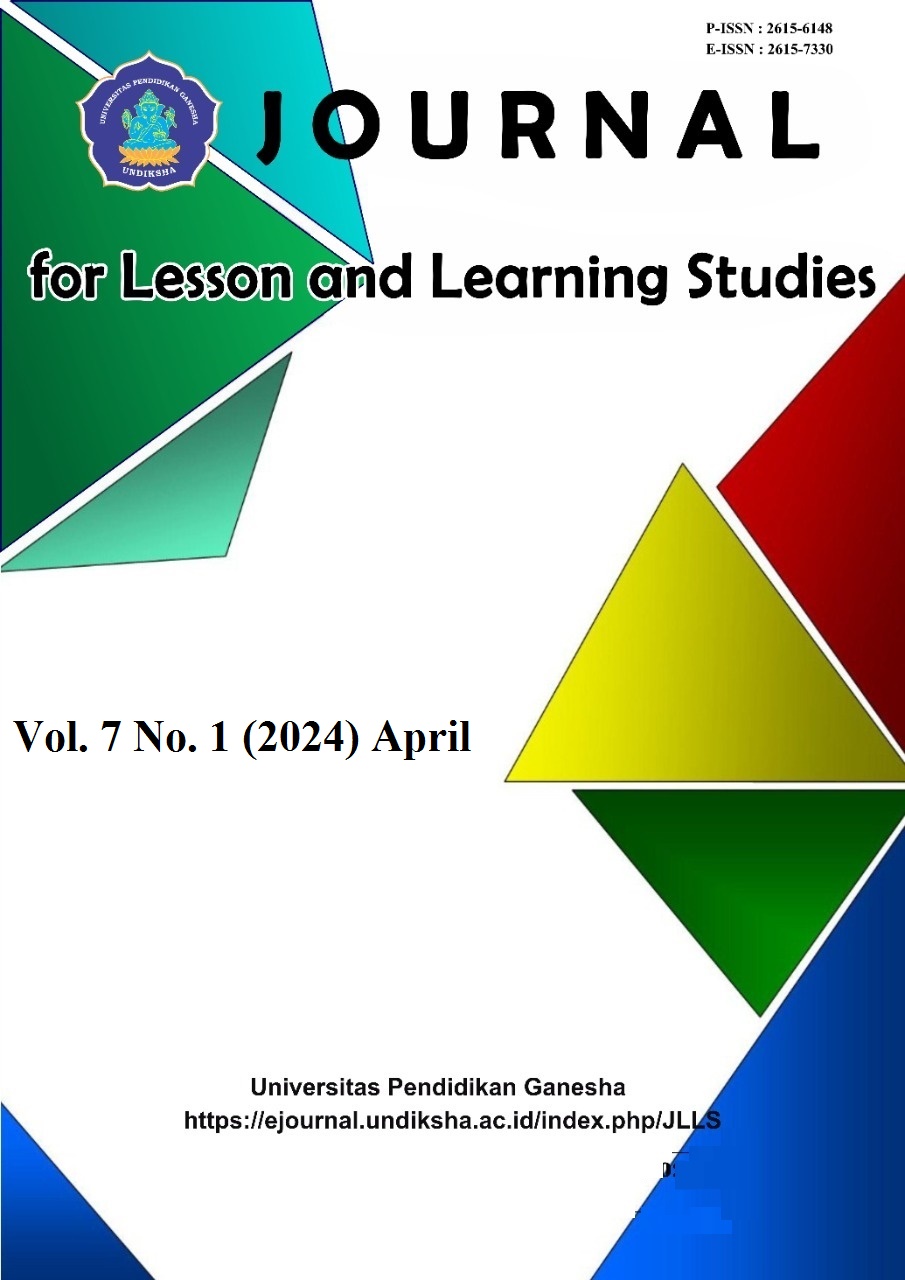Relationship among Perceived Usefulness, Ease of Use, Attitude and Intention to Use Emerging Technology among Undergraduate in South-West Nigeria
DOI:
https://doi.org/10.23887/jlls.v7i1.72043Keywords:
Emerging Technological Tools, Perception, Intention and Ease of UseAbstract
Emerging technological tools are innovative and instructional tools used to supplement traditional teaching and learning for the enhancement of students' positive academic performance. Despite its instructional benefits, they have not been fully utilized for learning among undergraduates in Nigeria. Hence, the study analyzes the relationship among perceived usefulness, ease of use, attitude and intention to use Emerging Technology among undergraduate in South-west Nigeria. The study adopted quantitative research design of survey type. The population was all undergraduates’ students in south-west, Nigeria out of which a sample of 1,412 were purposively sampled from 12 Federal and State universities in South-west, Nigeria. Data were collected through the administration of validated researcher-designed questionnaire. Percentages and mean scores were used to answer the research questions, while independent t-test and Analysis of variance (ANCOVA) was used to test the hypotheses at 0.05 level of significance. The findings indicated that there was no significant relationship among undergraduates perceived usefulness, ease of use, attitude and intention to use Emerging Technology in South-west Nigeria. The study concluded that Emerging Technological tools are better learning strategies for all undergraduates if well integrated in teaching and learning can help in improving undergraduates’ learning. The study recommended among others that undergraduates should be given the necessary supports on the provision of all needed facilities for proper utilization of the emerging technology for learning.
References
Ali, A., & Frew, A. J. (2013). Information and communication technologies for sustainable tourism. In Information and Communication Technologies for Sustainable Tourism (Vol. 8). Society of Interdisciplinary Business Research. https://doi.org/10.4324/9780203072592. DOI: https://doi.org/10.4324/9780203072592
Andyani, H., Setyosari, P., Wiyono, B. B., & Djatmika, E. T. (2020). Does Technological Pedagogical Content Knowledge Impact on the Use of ICT In Pedagogy? International Journal of Emerging Technologies in Learning (IJET), 15(3), 126. https://doi.org/10.3991/ijet.v15i03.11690. DOI: https://doi.org/10.3991/ijet.v15i03.11690
Anjarwati, P. G. P., Sajidan, & Prayitno, B. A. (2018). Problem-Based Learning Module of Environmental Changes to Enhance Studentsâ€TM Creative Thinking Skill. Biosaintifika: Journal of Biology & Biology Education, 10(2), 313–319. https://doi.org/10.15294/biosaintifika.v10i2.12598. DOI: https://doi.org/10.15294/biosaintifika.v10i2.12598
Arsić, Z., & Milovanović, B. (2016). Importance of computer technology in realization of cultural and educational tasks of preschool institutions. International Journal of Cognitive Research in Science, Engineering and Education, 4(1), 9–16. https://doi.org/10.5937/IJCRSEE1601009A. DOI: https://doi.org/10.5937/IJCRSEE1601009A
Batubara, H. H. (2017). engembangan Situs E-Learning Dengan Moodle Versi 3.1 Sebagai Media Pembelajaran Pada Program Studi Pendidikan Guru Madrasah Ibtidaiyah. AL-BIDAYAH: Jurnal Pendidikan Dasar Islam, 9(1), 1–10. https://doi.org/10.14421/al-bidayah.v9i1.116. DOI: https://doi.org/10.14421/al-bidayah.v9i1.116
Bhattacharjee, B., & Deb, K. (2016). Role of ICT in 21 st Century’s Teacher Education. International Journal of Education and Information Studies, 6(1), 1–6. http://library.oum.edu.my/oumlib/sites/default/files/file_attachments/odl-resources/4353/convergence-ict.pdf.
Çoban, M., & Göksu, İ. (2022). Using virtual reality learning environments to motivate and socialize undergraduates in distance learning. Participatory Educational Research, 9(2). https://doi.org/10.17275/per.22.36.9.2. DOI: https://doi.org/10.17275/per.22.36.9.2
Elmahdi, I., Al-Hattami, A., & Fawzi, H. (2018). Using Technology for Formative Assessment to Improve Students’ Learning. Turkish Online Journal of Educational Technology-TOJET, 17(2), 182–188. https://eric.ed.gov/?id=EJ1176157.
Fatmawati, F., Andriyani, N., & Ningsih, R. (2021). Digital Literacy: Teachers’ Perceptions of Using Google Accounts in the Online Learning Process. AL-ISHLAH: Jurnal Pendidikan, 13(2), 1017–1026. https://doi.org/10.35445/alishlah.v13i2.596. DOI: https://doi.org/10.35445/alishlah.v13i2.596
Gomez-del Rio, T., & Rodriguez, J. (2022). Design and assessment of a project-based learning in a laboratory for integrating knowledge and improving engineering design skills. Education for Chemical Engineers, 40(February), 17–28. https://doi.org/10.1016/j.ece.2022.04.002. DOI: https://doi.org/10.1016/j.ece.2022.04.002
Gunadi, G., Haryono, H., Purwanti, E., Raya, B. R., Pinoh Barat Melawi, T., & Kalimantan, W. (2022). The Analysis of 21 st Century Learning Implementation and Competency Achievement of Junior High School Students in 3T Regions. Innovative Journal of Curriculum and Educational Technology, 11(1), 10–18. https://doi.org/10.15294/IJCET.V11I1.44847. DOI: https://doi.org/10.15294/ijcet.v11i1.44847
Haatainen, O., & Aksela, M. (2021). Project-based learning in integrated science education: Active teachers’ perceptions and practices. Lumat, 9(1), 149–173. https://doi.org/10.31129/LUMAT.9.1.1392 DOI: https://doi.org/10.31129/LUMAT.9.1.1392
Hussin, W. N. T. W., Harun, J., & Shukor, N. A. (2019). Online interaction in social learning environment towards critical thinking skill: A framework. Journal of Technology and Science Education, 9(1), 4–12. https://doi.org/10.3926/jotse.544. DOI: https://doi.org/10.3926/jotse.544
Indrayana, B., & Sadikin, A. (2020). Penerapan E-Learning Di Era Revolusi Industri 4.0 Untuk Menekan Penyebaran Covid-19. Indonesian Journal of Sport Science and Coaching, 2(1), 46–55. https://doi.org/10.22437/ijssc.v2i1.9847. DOI: https://doi.org/10.22437/ijssc.v2i1.9847
Irwanto, Saputro, A. D., Rohaeti, E., & Prodjosantoso, A. K. (2018). Promoting critical thinking and Problem Solving Skills of Preservice Elementary Teachers through Process-Oriented Guided-Inquiry Learning (POGIL). International Journal of Instruction, 11(4). https://doi.org/10.12973/iji.2018.11449a. DOI: https://doi.org/10.12973/iji.2018.11449a
Jang, J., Ko, Y., Shin, W. S., & Han, I. (2021). Augmented Reality and Virtual Reality for Learning: An Examination Using an Extended Technology Acceptance Model. IEEE Access, 9, 6798–6809. https://doi.org/10.1109/ACCESS.2020.3048708 DOI: https://doi.org/10.1109/ACCESS.2020.3048708
Jang, M., Aavakare, M., Nikou, S., & Kim, S. (2021). The Impact of Literacy on Intention to Use Digital Technology for Learning: A Comparative Study of Korea and Finland. Telecommunications Policy, 45(7). https://doi.org/10.1016/j.telpol.2021.102154. DOI: https://doi.org/10.1016/j.telpol.2021.102154
Kesavan, K. P., & Palappallil, D. S. (2018). Effectiveness of formative assessment in motivating and improving the outcome of summative assessment in pharmacology for medical undergraduates. Journal of Clinical and Diagnostic Research, 12(5), FC08-FC11. https://doi.org/10.7860/JCDR/2018/34533.11527. DOI: https://doi.org/10.7860/JCDR/2018/34533.11527
Kumar, N., Rose, R. C., & D’Silva, J. L. (2008). Teachers’ readiness to use technology in the classroom: An empirical study. European Journal of Scientific Research, 21(4), 603–616. https://www.researchgate.net/profile/Jeffrey-Lawrence-2/publication/239764656.
Lampropoulos, G., Siakas, K., & Anastasiadis, T. (2019). Internet of Things in the Context of Industry 4.0: An Overview. International Journal of Entrepreneurial Knowledge, 7(1), 4–19. https://doi.org/10.2478/ijek-2019-0001. DOI: https://doi.org/10.2478/ijek-2019-0001
Maamuujav, U., Krishnan, J., & Collins, P. (2019). The utility of infographics in L2 writing classes: A practical strategy to scaffold writing development. TESOL Journal, September. https://doi.org/10.1002/tesj.484. DOI: https://doi.org/10.1002/tesj.484
Majid, S. N. A., & Salam, A. R. (2021). A Systematic Review of Augmented Reality Applications in Language Learning. International Journal of Emerging Technologies in Learning, 16(10). https://doi.org/10.3991/ijet.v16i10.17273. DOI: https://doi.org/10.3991/ijet.v16i10.17273
Martín, C. T., Acal, C., Honrani, M. El, & Estrada, Á. C. M. (2021). Impact on the virtual learning environment due to covid-19. Sustainability (Switzerland), 13(2), 1–16. https://doi.org/10.3390/su13020582. DOI: https://doi.org/10.3390/su13020582
Meier, E. B. (2021). Designing and using digital platforms for 21st century learning. Educational Technology Research and Development, 69(1), 217–220. https://doi.org/10.1007/s11423-020-09880-4. DOI: https://doi.org/10.1007/s11423-020-09880-4
Meyers, E. M., Erickson, I., & Small, R. V. (2013). Digital literacy and informal learning environments: An introduction. Learning, Media and Technology, 38(4), 355–367. https://doi.org/10.1080/17439884.2013.783597. DOI: https://doi.org/10.1080/17439884.2013.783597
Miranda, J., Navarrete, C., Noguez, J., Molina-Espinosa, J. M., Ramírez-Montoya, M. S., Navarro-Tuch, S. A., Bustamante-Bello, M. R., Rosas-Fernández, J. B., & Molina, A. (2021). The core components of education 4.0 in higher education: Three case studies in engineering education. Computers and Electrical Engineering, 93(February), 1-13. https://doi.org/10.1016/j.compeleceng.2021.107278. DOI: https://doi.org/10.1016/j.compeleceng.2021.107278
Morrar, R., Arman, H., & Mousa, S. (2017). The fourth industrial revolution (Industry 4.0): A social innovation perspective. Technology Innovation Management Review, 7(11), 12–20. https://timreview.ca/sites/default/files/Issue_PDF/TIMReview_November2017.pdf#page=12. DOI: https://doi.org/10.22215/timreview/1117
Mukarromah, U., & Wijayanti, W. (2021). Implementation of the online learning at vocational high school during Covid-19: Between obligations and barriers. Jurnal Pendidikan Vokasi, 11(1). https://doi.org/10.21831/jpv.v11i1.37110. DOI: https://doi.org/10.21831/jpv.v11i1.37110
Nassaji, H. (2015). Qualitative and descriptive research: Data type versus data analysis. Language Teaching Research, 19(2), 129–132. https://doi.org/10.1177/1362168815572747. DOI: https://doi.org/10.1177/1362168815572747
Nee, C. C., Yunus, M. M., & Suliman, A. (2019). ICT: An Effective Platform to Promote Writing Skills among Chinese Primary School Pupils. Arab World English Journal, 10(4), 223–237. https://doi.org/10.24093/awej/vol10no4.17. DOI: https://doi.org/10.24093/awej/vol10no4.17
Nesbit, J. C., & Li, J. (2004). Web-based tools for learning object evaluation. In International Conference on Education and Information Systems, 21–25. http://sn4re.note4research.com/sn4re/app/data/dasaw/2553.pdf.
Parno, Nur’aini, D. A., Kusairi, S., & Ali, M. (2022). Impact of The STEM approach with formative assessment in PjBL on students’ critical thinking skills. The 1st International Conference Science Physics and Education 2021 (ICSPE 2021), 2165(1). https://doi.org/10.1088/1742-6596/2165/1/012044. DOI: https://doi.org/10.1088/1742-6596/2165/1/012044
Reddy, P., Sharma, B., & Chaudhary, K. (2022). Digital literacy: a review in the South Pacific. Journal of Computing in Higher Education, 34(1), 83–108. https://doi.org/10.1007/s12528-021-09280-4. DOI: https://doi.org/10.1007/s12528-021-09280-4
Su, Y.-S., Cheng, H.-W., & Lai, C.-F. (2022). Study of Virtual Reality Immersive Technology Enhanced Mathematics Geometry Learning. Frontiers in Psychology, 13(February), 1–8. https://doi.org/10.3389/fpsyg.2022.760418. DOI: https://doi.org/10.3389/fpsyg.2022.760418
Supeni, S., Hakim, L., & Jumintono. (2019). Strengthening Character Education of Early Childhood through Javanese Traditional Game Dakon. International Journal of Recent Technology and Engineering, 7(6S2), 243–249. https://www.atlantis-press.com/proceedings/ijcah-20/125947406.
Tang, T., Vezzani, V., & Eriksson, V. (2020). Developing critical thinking, collective creativity skills and problem solving through playful design jams. Thinking Skills and Creativity, 37(May), 100696. https://doi.org/10.1016/j.tsc.2020.100696. DOI: https://doi.org/10.1016/j.tsc.2020.100696
Tuuri, K., & Koskela, O. (2020). Understanding Human–Technology Relations Within Technologization and Appification of Musicality. Frontiers in Psychology, 11(April), 1–14. https://doi.org/10.3389/fpsyg.2020.00416. DOI: https://doi.org/10.3389/fpsyg.2020.00416
Wen, X., & Walters, S. M. (2022). The Impact of Technology on Students’ Writing Performances in Elementary Classrooms: A Meta-Analysis. Computers and Education Open, 3, 100082. https://doi.org/10.1016/j.caeo.2022.100082. DOI: https://doi.org/10.1016/j.caeo.2022.100082
Widodo, S. F. A., Wibowo, Y. E., & Wagiran, W. (2020). Online learning readiness during the Covid-19 pandemic. Journal of Physics: Conference Series, 1700(1), 12033. https://doi.org/10.1088/1742-6596/1700/1/012033. DOI: https://doi.org/10.1088/1742-6596/1700/1/012033
Williams, M. K., Foulger, T. S., & Wetzel, K. (2009). Preparing Preservice Teachers for 21st Century Classrooms: Transforming Attitudes and Behaviors About Innovative Technology. Journal of Technology and Teacher Education, 17(3), 393–418. https://www.learntechlib.org/primary/p/28216/.
Yeni, S., & Cagiltay., K. (2017). A heuristic evaluation to support the instructional and enjoyment aspects of a math game. Program, 51(4), 406–423. https://doi.org/10.1108/ PROG-07-2016-0050. DOI: https://doi.org/10.1108/PROG-07-2016-0050
Downloads
Published
How to Cite
Issue
Section
License
Copyright (c) 2023 Sakiru Sulaimon Keji

This work is licensed under a Creative Commons Attribution-ShareAlike 4.0 International License.
Authors who publish with the Journal for Lesson and Learning Studies agree to the following terms:
- Authors retain copyright and grant the journal the right of first publication with the work simultaneously licensed under a Creative Commons Attribution License (CC BY-SA 4.0) that allows others to share the work with an acknowledgment of the work's authorship and initial publication in this journal.
- Authors are able to enter into separate, additional contractual arrangements for the non-exclusive distribution of the journal's published version of the work (e.g., post it to an institutional repository or publish it in a book), with an acknowledgment of its initial publication in this journal.
- Authors are permitted and encouraged to post their work online (e.g., in institutional repositories or on their website) prior to and during the submission process, as it can lead to productive exchanges, as well as earlier and greater citation of published work. (See The Effect of Open Access)




